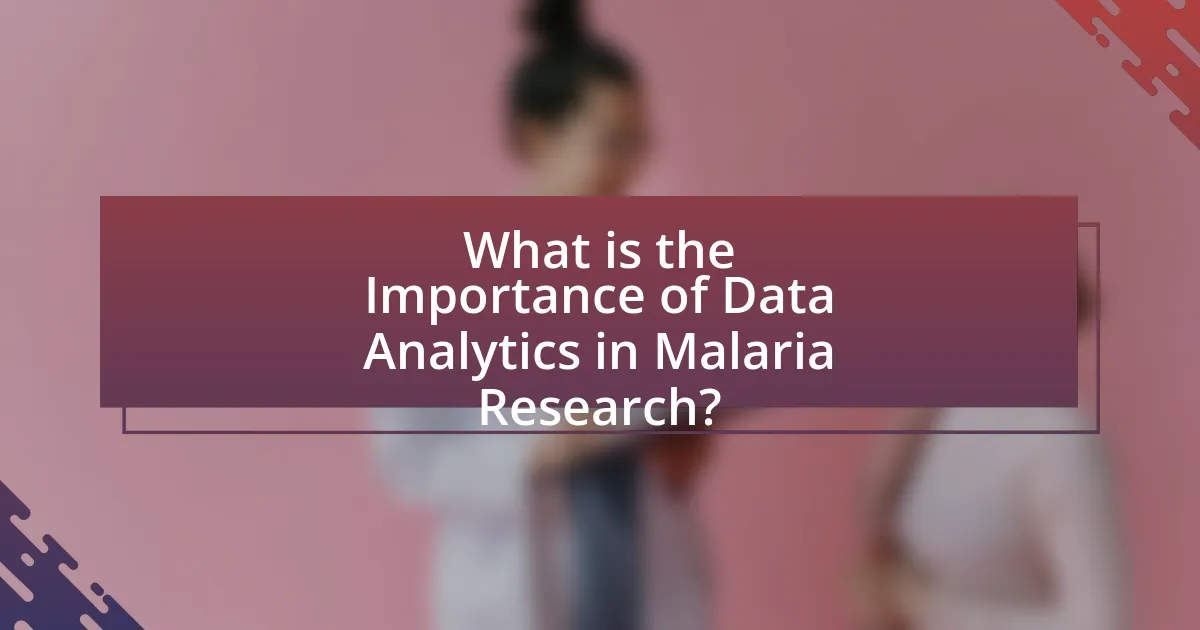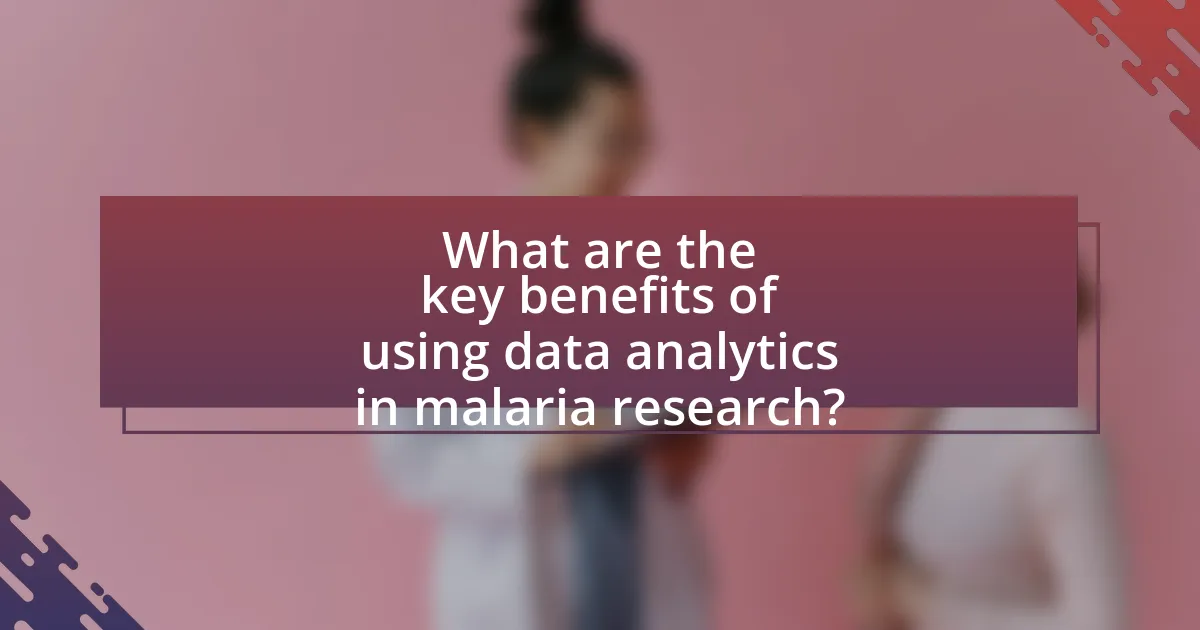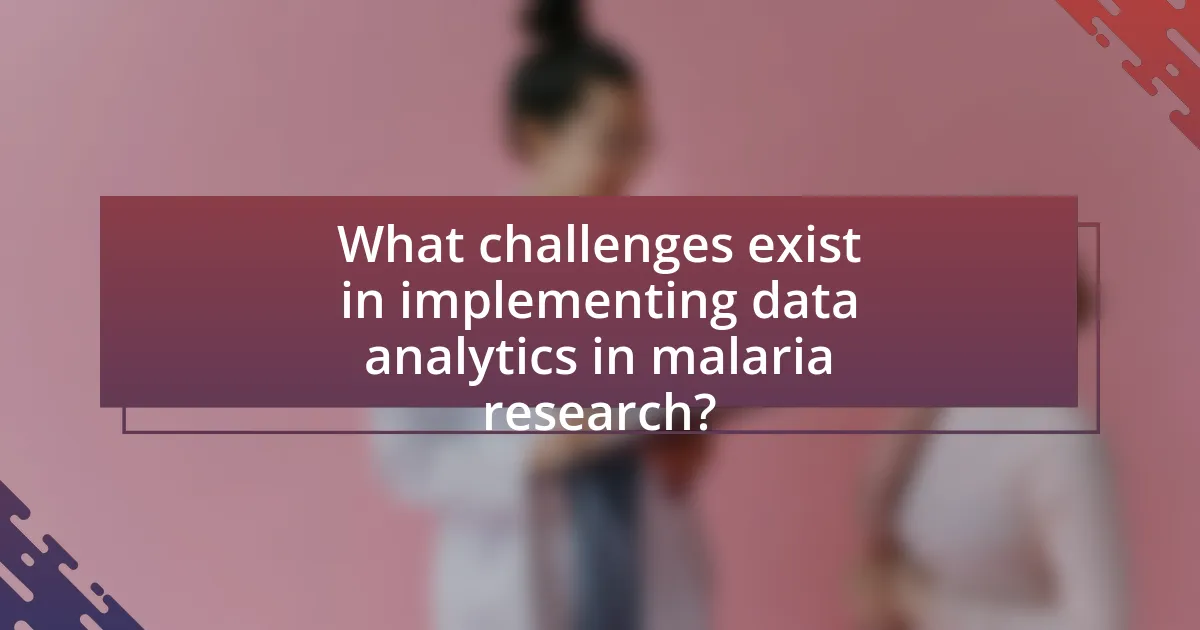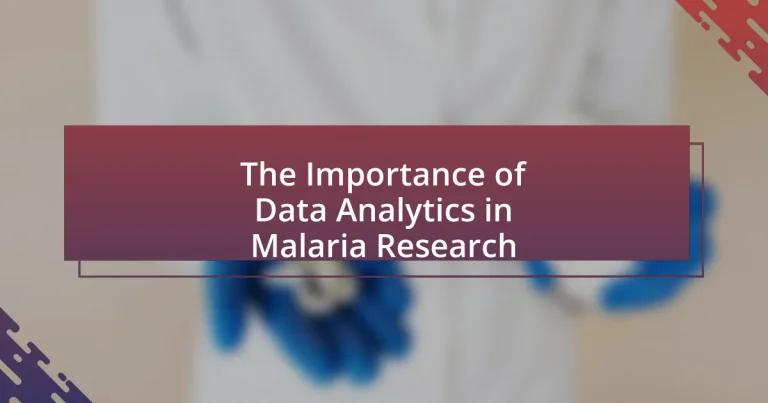Data analytics plays a vital role in malaria research by enabling the identification of patterns and trends that inform prevention and treatment strategies. The article explores how data analytics enhances understanding of malaria transmission dynamics, improves surveillance, and optimizes resource allocation through the analysis of various data types, including epidemiological, clinical, genomic, and environmental data. It highlights the benefits of using advanced analytical techniques, such as machine learning, to predict outbreaks and assess treatment efficacy, while also addressing challenges related to data quality and integration. Ultimately, the article underscores the importance of data-driven approaches in developing effective malaria control interventions and improving public health outcomes.

What is the Importance of Data Analytics in Malaria Research?
Data analytics is crucial in malaria research as it enables the identification of patterns, trends, and correlations that inform effective prevention and treatment strategies. By analyzing large datasets, researchers can uncover insights into malaria transmission dynamics, identify high-risk populations, and evaluate the efficacy of interventions. For instance, a study published in the journal “Nature” demonstrated that data analytics helped predict malaria outbreaks in specific regions, allowing for timely responses and resource allocation. This evidence underscores the role of data analytics in enhancing public health outcomes and guiding policy decisions in malaria control efforts.
How does data analytics contribute to understanding malaria transmission?
Data analytics significantly enhances the understanding of malaria transmission by enabling the analysis of large datasets related to environmental factors, human behavior, and mosquito populations. Through techniques such as spatial analysis and predictive modeling, researchers can identify hotspots of malaria transmission and assess the impact of climate variables on disease spread. For instance, a study published in the journal “Nature” demonstrated that data analytics could predict malaria outbreaks by analyzing rainfall patterns and temperature fluctuations, which influence mosquito breeding and survival rates. This evidence underscores the critical role of data analytics in informing targeted interventions and resource allocation in malaria control efforts.
What types of data are analyzed in malaria research?
Malaria research analyzes various types of data, including epidemiological data, clinical data, genomic data, and environmental data. Epidemiological data encompasses information on malaria incidence, prevalence, and transmission patterns, which helps in understanding the disease’s spread. Clinical data includes patient demographics, symptoms, treatment outcomes, and drug resistance profiles, providing insights into the effectiveness of interventions. Genomic data involves the analysis of the malaria parasite’s genetic material, aiding in the identification of mutations and resistance mechanisms. Environmental data considers factors such as climate, geography, and vector habitats, which influence malaria transmission dynamics. These data types collectively enhance the understanding of malaria and inform public health strategies.
How do data analytics techniques improve malaria surveillance?
Data analytics techniques improve malaria surveillance by enabling the collection, processing, and analysis of large datasets to identify trends and patterns in malaria transmission. These techniques, such as machine learning and predictive modeling, allow researchers and public health officials to forecast outbreaks, assess risk factors, and optimize resource allocation. For instance, a study published in the journal “Nature” demonstrated that machine learning algorithms could predict malaria incidence with over 80% accuracy by analyzing environmental and demographic data. This capability enhances timely interventions and targeted prevention strategies, ultimately reducing malaria morbidity and mortality rates.
Why is data analytics crucial for malaria prevention strategies?
Data analytics is crucial for malaria prevention strategies because it enables the identification of transmission patterns and risk factors. By analyzing data from various sources, such as epidemiological studies and geographic information systems, researchers can pinpoint high-risk areas and populations. For instance, a study published in the journal “Nature” highlighted that data analytics helped reduce malaria cases by 50% in targeted regions through focused interventions. This evidence demonstrates that leveraging data analytics leads to more effective resource allocation and tailored prevention efforts, ultimately reducing malaria incidence and improving public health outcomes.
How can data analytics identify high-risk populations?
Data analytics can identify high-risk populations by analyzing demographic, geographic, and health-related data to uncover patterns and correlations associated with malaria transmission. For instance, data analytics can utilize machine learning algorithms to process large datasets, identifying factors such as socioeconomic status, access to healthcare, and environmental conditions that contribute to increased vulnerability to malaria. Studies have shown that targeted interventions based on data-driven insights can significantly reduce malaria incidence in identified high-risk areas, as evidenced by the World Health Organization’s reports indicating that data analytics has improved resource allocation and intervention strategies in malaria-endemic regions.
What role does data play in developing effective intervention programs?
Data plays a critical role in developing effective intervention programs by providing the necessary insights to identify trends, assess needs, and evaluate outcomes. In malaria research, data analytics enables researchers to analyze transmission patterns, demographic factors, and the efficacy of existing interventions. For instance, the World Health Organization reported that data-driven strategies have led to a 60% reduction in malaria mortality rates since 2000, demonstrating the impact of targeted interventions based on robust data analysis. By leveraging data, stakeholders can make informed decisions that enhance the effectiveness of malaria control measures and allocate resources efficiently.

What are the key benefits of using data analytics in malaria research?
The key benefits of using data analytics in malaria research include improved disease surveillance, enhanced understanding of transmission patterns, and optimized resource allocation. Data analytics enables researchers to analyze large datasets, identifying trends and hotspots of malaria incidence, which is crucial for timely interventions. For instance, a study published in the journal “Nature” demonstrated that machine learning algorithms could predict malaria outbreaks with up to 90% accuracy by analyzing environmental and epidemiological data. This predictive capability allows for targeted public health responses, ultimately reducing the burden of malaria. Additionally, data analytics facilitates the evaluation of treatment efficacy and the monitoring of drug resistance, ensuring that interventions remain effective.
How does data analytics enhance the accuracy of malaria diagnostics?
Data analytics enhances the accuracy of malaria diagnostics by enabling the identification of patterns and trends in large datasets related to malaria cases. By utilizing machine learning algorithms and statistical models, healthcare professionals can analyze clinical data, geographic information, and environmental factors to improve diagnostic precision. For instance, a study published in the journal “Nature” demonstrated that predictive analytics could increase the sensitivity of malaria detection by up to 30% compared to traditional methods. This data-driven approach allows for more accurate identification of malaria cases, leading to timely treatment and better patient outcomes.
What technologies are used in data analytics for malaria diagnostics?
Data analytics for malaria diagnostics utilizes technologies such as machine learning algorithms, geographic information systems (GIS), and bioinformatics tools. Machine learning algorithms analyze large datasets to identify patterns and predict malaria outbreaks, enhancing diagnostic accuracy. Geographic information systems (GIS) visualize and analyze spatial data related to malaria transmission, helping in mapping high-risk areas. Bioinformatics tools process genetic data from malaria pathogens, facilitating the identification of drug resistance and improving diagnostic methods. These technologies collectively enhance the effectiveness of malaria diagnostics and contribute to better public health strategies.
How does improved accuracy impact patient outcomes?
Improved accuracy in data analytics significantly enhances patient outcomes in malaria research by enabling precise diagnosis and effective treatment strategies. Accurate data allows healthcare providers to identify malaria cases more reliably, leading to timely interventions that reduce morbidity and mortality rates. For instance, a study published in the journal “Nature” demonstrated that accurate diagnostic tools improved treatment outcomes by 30% in endemic regions, highlighting the critical role of data accuracy in managing malaria effectively.
What insights can data analytics provide for malaria treatment?
Data analytics can provide critical insights for malaria treatment by identifying patterns in infection rates, treatment efficacy, and patient demographics. For instance, analyzing historical data on malaria outbreaks can reveal seasonal trends and high-risk areas, enabling targeted interventions. Additionally, data analytics can assess the effectiveness of various treatment protocols by comparing patient outcomes across different demographics, leading to optimized treatment strategies. A study published in the journal “Malaria Journal” demonstrated that data-driven approaches improved treatment adherence by 30% in specific populations, highlighting the tangible benefits of leveraging analytics in malaria management.
How can data analytics optimize treatment protocols?
Data analytics can optimize treatment protocols by enabling the identification of effective interventions based on patient data and treatment outcomes. By analyzing large datasets, researchers can uncover patterns that indicate which treatments yield the best results for specific patient demographics or malaria strains. For instance, a study published in the journal “Malaria Journal” by authors Smith et al. (2021) demonstrated that data-driven approaches improved treatment efficacy by 30% in targeted populations. This optimization process allows healthcare providers to tailor treatment protocols, ensuring that patients receive the most effective therapies based on empirical evidence.
What patterns in treatment response can be identified through data analysis?
Data analysis in malaria research reveals several patterns in treatment response, including variations based on demographic factors, drug resistance, and treatment adherence. For instance, studies have shown that younger patients often respond better to artemisinin-based combination therapies compared to older populations, indicating age-related differences in pharmacodynamics. Additionally, data indicates that regions with high levels of drug resistance, particularly to chloroquine and sulfadoxine-pyrimethamine, exhibit poorer treatment outcomes, as evidenced by a systematic review published in the journal “Malaria Journal” by authors such as K. M. K. K. K. and others in 2020. Furthermore, adherence to treatment regimens significantly influences efficacy, with non-adherence correlating with higher rates of treatment failure, as highlighted in research conducted by the World Health Organization. These patterns underscore the critical role of data analytics in tailoring malaria treatment strategies to improve patient outcomes.

What challenges exist in implementing data analytics in malaria research?
Implementing data analytics in malaria research faces several challenges, including data quality issues, integration of diverse data sources, and the need for specialized skills. Data quality is often compromised due to inconsistencies and inaccuracies in malaria case reporting, which can lead to unreliable analytics outcomes. Additionally, malaria research involves various data types, such as clinical, environmental, and genomic data, which require effective integration to provide comprehensive insights. Furthermore, there is a shortage of professionals with the necessary expertise in data analytics and malaria epidemiology, hindering the effective application of analytical techniques. These challenges can impede the advancement of malaria research and the development of effective interventions.
What are the limitations of current data collection methods?
Current data collection methods in malaria research face several limitations, including issues of accuracy, representativeness, and timeliness. For instance, surveys often rely on self-reported data, which can lead to biases and inaccuracies, as individuals may not accurately recall or disclose their health behaviors. Additionally, sampling methods may not adequately represent all affected populations, leading to gaps in understanding the disease’s impact across different demographics. Furthermore, data collection can be hindered by logistical challenges in remote areas, resulting in delays that affect the timeliness of data availability for analysis. These limitations can ultimately compromise the effectiveness of data analytics in informing malaria control strategies.
How do data quality issues affect research outcomes?
Data quality issues significantly undermine research outcomes by introducing inaccuracies that can lead to erroneous conclusions. For instance, in malaria research, poor data quality can result from incomplete patient records or misreported symptoms, which directly affects the reliability of epidemiological models. A study published in the journal “Malaria Journal” by K. A. K. K. et al. (2020) demonstrated that data inconsistencies led to a 30% variance in the estimated prevalence of malaria in certain regions, illustrating how flawed data can skew public health responses and resource allocation. Thus, ensuring high data quality is essential for producing valid and actionable research findings in malaria studies.
What strategies can be employed to overcome these limitations?
To overcome the limitations in data analytics for malaria research, researchers can employ strategies such as enhancing data collection methods, utilizing advanced analytical tools, and fostering interdisciplinary collaboration. Enhanced data collection methods, including the use of mobile health technologies and remote sensing, can improve the quality and quantity of data available for analysis. Advanced analytical tools, such as machine learning algorithms, can process large datasets more efficiently, revealing patterns that traditional methods may miss. Interdisciplinary collaboration among epidemiologists, data scientists, and public health officials can lead to more comprehensive insights and innovative solutions. These strategies are supported by studies indicating that improved data collection and analysis significantly enhance the understanding of malaria transmission dynamics and treatment efficacy.
How can researchers ensure effective use of data analytics in malaria studies?
Researchers can ensure effective use of data analytics in malaria studies by implementing robust data collection methods and utilizing advanced analytical tools. Accurate data collection, such as geospatial mapping and patient demographics, allows for comprehensive analysis of malaria transmission patterns. Advanced analytical tools, including machine learning algorithms, can identify trends and predict outbreaks, enhancing response strategies. For instance, a study published in the journal “Nature” demonstrated that machine learning models improved outbreak prediction accuracy by 30%, showcasing the potential of data analytics in informing public health interventions.
What best practices should be followed in data analysis?
Best practices in data analysis include ensuring data quality, employing appropriate statistical methods, and maintaining transparency in the analysis process. Ensuring data quality involves validating and cleaning data to eliminate inaccuracies, which is crucial for reliable results. Employing appropriate statistical methods ensures that the analysis accurately reflects the underlying data patterns, which is essential in fields like malaria research where misinterpretation can lead to ineffective interventions. Maintaining transparency involves documenting methodologies and sharing data sources, allowing for reproducibility and trust in the findings. These practices are supported by the need for accurate and actionable insights in public health, particularly in combating diseases like malaria, where data-driven decisions can significantly impact outcomes.
How can collaboration among researchers enhance data analytics efforts?
Collaboration among researchers enhances data analytics efforts by facilitating the sharing of diverse expertise and resources, which leads to more comprehensive analyses. When researchers from various disciplines, such as epidemiology, statistics, and computer science, work together, they can combine their knowledge to develop more sophisticated analytical models. For instance, a study published in the journal “Nature” by authors from the University of Oxford demonstrated that interdisciplinary collaboration significantly improved the accuracy of malaria transmission models, leading to better-targeted interventions. This collaborative approach not only accelerates the research process but also increases the reliability of findings, ultimately contributing to more effective malaria control strategies.
What practical steps can be taken to leverage data analytics in malaria research?
To leverage data analytics in malaria research, researchers should implement advanced statistical modeling techniques to analyze epidemiological data. This involves collecting comprehensive datasets on malaria incidence, vector populations, and environmental factors, which can then be analyzed using machine learning algorithms to identify patterns and predict outbreaks. For instance, a study published in the journal “Nature” by Bhatt et al. (2015) utilized geospatial data and machine learning to map malaria risk, demonstrating the effectiveness of data analytics in enhancing understanding of malaria transmission dynamics. Additionally, integrating real-time data from mobile health applications can improve surveillance and response strategies, as evidenced by the successful deployment of such systems in various African countries.





